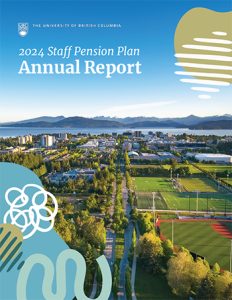The Canada Revenue Agency (CRA) places limits on how much money you can shelter from taxation in a registered plan each year. As a result, the amount of money you may contribute to an RRSP is affected when you belong to a registered pension plan such as the UBC Staff Pension Plan (SPP).
What is my RRSP contribution room?
The amount you can shelter in an RRSP is called your “contribution room.” The annual Notice of Assessment you receive each year from the CRA tells you how much RRSP room you have for the current year. Your contribution room is:
18% of your previous year’s earned income up to the CRA maximum
minus your Pension Adjustment (PA) for the previous year
What is a Pension Adjustment (PA)?
A Pension Adjustment (PA) is the deemed value, for tax purposes, that is placed on the benefit accruing under a registered pension plan or deferred profit sharing plan in a particular year. It is shown in box 52 of your T4 tax information slip, along with your annual pension contributions in Box 20. PAs were introduced to the Staff Pension Plan in the year 1990.
What does a PA represent?
Your PA is the approximate value of your accrued pension earned each year. Canada Revenue Agency (CRA) uses your PA to calculate your RRSP contribution limit.
As the accrued pension benefits in the UBC SPP are salary and service driven, so is the PA. It is important to remember that the required contributions you make have no impact on this calculation.
How is the PA calculated?
CRA specifies a formula to calculate your PA in a given year:
9 times the pension earned in the year (calculated by the pension formula)
minus $600
Where can I see the details of my PA calculation?
Your most recent PA calculation is available on myPension. Log in and select Calculators > Pension Adjustment.
How does the PA affect my RRSP Contribution Room?
Each February, the University must report a Pension Adjustment (PA) to Canada Revenue Agency (CRA) on your T4 slip. The PA is the value of the pension benefit you earn under the Plan. CRA uses your income tax return and T4 to calculate your maximum RRSP contribution room, which is then reported to you each year. Your RRSP contribution limit for the current year is based on your earned income and PA from the previous year.
When an employee terminates employment before retirement age, the termination value from the pension plan may be less than the total value reported as Pension Adjustments. This is because PA values reflect the value of pension at retirement age. The termination refund is based upon the value of the pension at retirement age. The termination PA which reduces your RRSP contribution room may be exaggerated.
To address this inequity, the Federal Government introduced Pension Adjustment Reversals (PARs).
Please visit the Canada Revenue Agency website to learn more about Pension Adjustments (PAs).
What is a Pension Adjustment Reversal (PAR)?
A Pension Adjustment Reversal (PAR) allows individuals to restore the full value of their RRSP room. A PAR applies to Plan members who terminated employment after 1996 and who choose a refund from the Plan before retirement.
Why Would I be given a PAR?
If a member terminates their membership in the SPP and elects to transfer the value of their pension out of the Plan, we calculate a PAR. A PAR is the difference between the member’s termination benefit and the total of their Pension Adjustments while they were a member of the SPP. A PAR is used to restore lost RRSP room.
Please visit the Canada Revenue Agency website to learn more about Pension Adjustments (PAs).
Unused RRSP Room
Unused contribution room is carried forward from year to year. If you have not contributed the full amount allowed in the past, your contribution room will be greater than 18% of earned income minus your PA.
If you have extra contribution room, there is a tax advantage to contributing as much as you can. However, be careful not to contribute more than the limit shown on your Notice of Assessment or you may have to pay a penalty.
Tax Tip on Pension Income Splitting
Tax rules effective January 1, 2007 allow eligible taxpayers to allocate up to half of their eligible pension income (income that qualifies for the pension income tax credit) to their lower-earning spouse or common-law partner. Please review the Canada Revenue Agency – Pension Income Splitting page for more information. To make this election, you and your spouse or common-law partner must each complete Form T1032: Joint Election to Split Pension Income.
